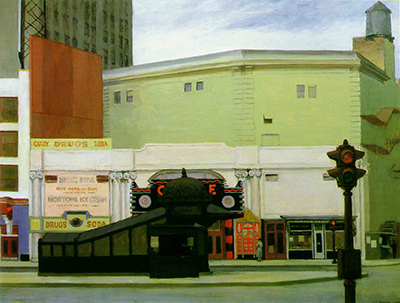Edward Hopper (1882 - 1967) was an American artist and master of both oil paintings and watercolours. Frequently drawing on the commonplace, Hopper focused on the quiet and still moments of American daily life.
His work has been greatly influential in the art world, establishing a tradition of American art in the twentieth-century. Hopper's work is often considered as being "realist" or of a New Realist style, but his interests and training have included Impressionism among others.
This realism frequently evoked modern loneliness and isolation; it worked in counterpoint to America's growing optimism, particularly in the postwar period.
Hopper first trained as an illustrator, devoting his time to etchings and working for advertisement firms. Hopper soon began to take up painting and was influenced by several trips to Paris in his twenties. Beginning as a self-declared devotee of Claude Monet and Edouard Manet, Hopper was unfazed by Cubism in Europe and began painting in a deeply evocative, but realist style.
Achieving his first wave of successes in the 1920s, he owed this promotion to his wife, Josephine Nivison, and her championing of his work as manager and promoter. Although Hopper's successes waned with Abstract Expressionism in the postwar period, his work has remained influential to modern filmmakers, writers and photographers, particularly for its distinctly cinematic, brooding and emotionally resonant mise en scène.
The Circle Theatre reflects many of these filmic and melancholic elements, framing a single isolated figure within an empty, but visually busy, urban landscape.
The Circle Theatre was painted in 1936 at the height of Hopper's visual maturity. Almost immediately purchased by the Whitney Museum that December, The Circle Theatre brought Hopper new prosperity and respect.
In the painting, Hopper defamiliarises his audience with the subject by controlling and dwarfing the buildings in relation to the street, carefully (and dimly) lighting the shopfronts and giving a sense of inertia in the absence of movement. The one human figure stands small in the coloured facades of the surrounding architecture.
Although Hopper was reluctant to discuss his work, the trope of human isolation and depression pervade The Circle Theatre. Both Hopper's use of colour contrast and his compositional structure emphasise the tensions between man and the landscape, creating a sense of overwhelming seclusion.




